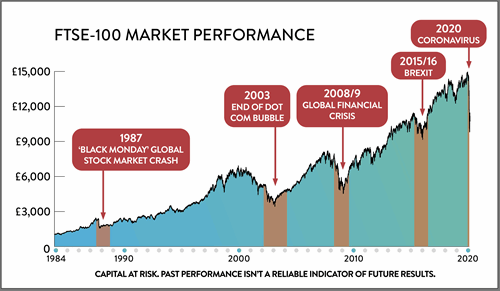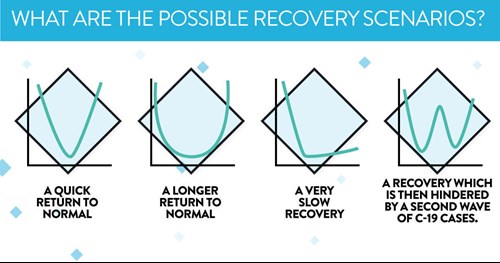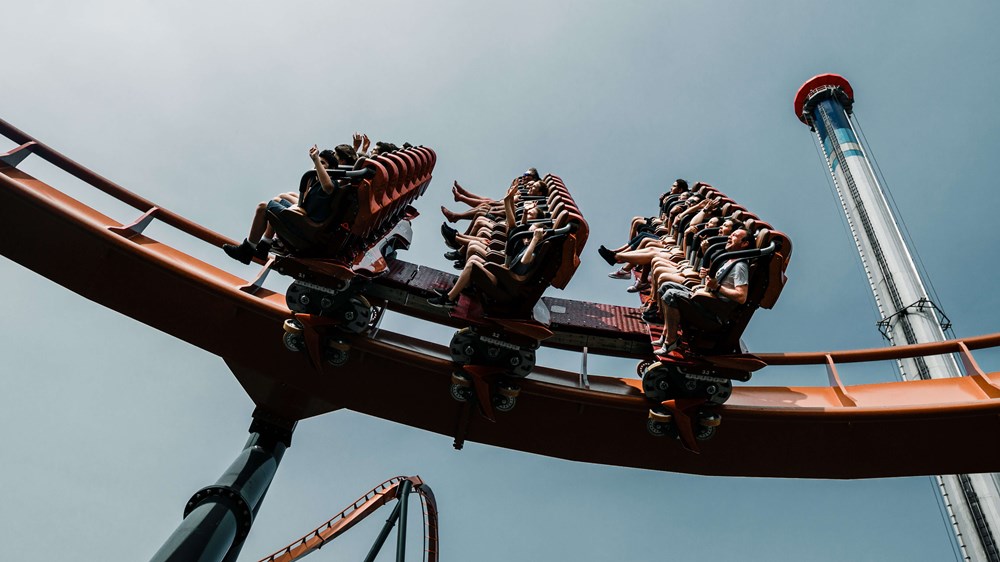Please note: this blog was published in May 2020 and its content is based on what was correct at the time of writing. As a result, some of the facts and opinions may no longer be current or relevant.
We may have won the Best Investment Provider at the British Bank Awards 2020, but even our investment team can’t predict the future. That said, they do a lot of research, and even that is underselling it. This does mean that we can make informed predictions, but when it comes to knowing where the markets are heading or when they’ll recover we simply can’t give you an answer. In fact, nobody can, and you should be wary of anyone saying otherwise.
Let’s look at the facts
Typically, bear markets – which is when prices decrease by more than 20% - don’t last as long as bull markets, when prices are up by 20% (find out more about bear and bull markets here). The graph below shows how short they’ve been in the past by looking at the FTSE100, which accounts for 100 of the largest listed companies in the UK. See all the blue? That’s a bull market – even those dips in it. Investing isn’t a smooth ride at the best of times, there are always fluctuations, and bear markets form a necessary part of that.


But none of this tells you how long we can expect this current bear markets to last. And sadly, if you were expecting a certain date, you won’t get it – not just because we don’t provide advice at Wealthify, but because so many factors influence the outcome it’s truly impossible to try and predict.
Why are we in a bear market?
This is perhaps one of the most interesting bear markets in history, as the downturn was driven unquestionably by covid-19. The pandemic led to unprecedented measures carried out to stop the spread of the virus and support the economy in these difficult times. Across the world, we’ve seen countries going into lockdown, schools, shops, industries paused, and travel restrictions put in place. All of these have a huge impact on businesses, consumers, and the economy, causing the stock market to drop by more than 30% in the space of a month[1].
Part of the reason for this is the uncertainty surrounding the virus. It has caused a global impact, affecting Asia, Europe and America in different, but significant ways. Many governments called for immediate shut-down of non-essential travel and services, which resulted in a high level of unemployment – in the US for example, it jumped to 4.4% in March 2020, the highest it’s been since August 2017[2]. This will, almost certainly, result in a reduction of public spending which could have a further negative impact on production and the economy.
But, it’s not all bad news. In reaction to this virus and the impact it’s causing, we’ve seen governments introducing a huge number of policies to try and reduce the overall impact on the economy. One of these measures has been increased government spending, with the US and Germany introducing a $2trillion and a €750billion spending package, respectively. Similarly, the UK introduced an 80% income protection plan to provide employed and self-employed with a salary if they are put on ‘furlough’ during these times.
What can we expect?
Again, there are a lot of different potential recovery scenarios, ranging from this being a quick, short-term dip through to a much more prolonged stock market recovery. But nobody really knows what to expect, however, there are four theories which look a bit like this:


- The V. This is essentially a quick return to normal, and it’s supported by the fact that there was a strong economy and stock market prior to the pandemic.
- The U. This is a longer return to normal, with lockdown removal taking place gradually with some countries taking longer to recover than others.
- The L. A much slower recovery, which could happen if health concerns continue or we see the lockdown and pause of businesses extended for prolonged periods.
- The W. In this scenario, we would see a recovery similar to the V, but then be hindered by a second wave of COVID-19 cases.
Nobody will know for sure which of these scenarios, if any, have happened until we’ve seen it play out. There’s a lot of evidence which could support each of these options, and many more besides, as it becomes a matter of opinion, speculation, and educated guesswork.
Should I try to time the market?
There’s an idea in investing called ‘timing the market’ which is essentially trying to predict when the market is at its lowest and choose then to purchase. While the theory is sound, your chances of accurately predicting the market is very, very low. Plus, if you don’t have money invested at the time, then you could be missing out on some of the best days within the dip.
Perhaps a better solution would be to pay into your investment account little and often? This way you’re buying investments at lots of different prices, and if you invested the same amount, then you’d potentially get more for your money when the markets are down. This approach is a sound investment strategy, called pound-cost averaging, and over the long-term, it can work to smooth out the peaks and troughs in investing.
Not only is this a proven strategy, but with Wealthify, you can do it automatically. Simply create a Direct Debit into your Investment Plan and leave it to our experts. Our team carefully monitor the markets and will invest your money regularly, helping you to take advantage of a wide range of prices within your investments. Then, if the markets recover, you’ll have a Plan, or your Stocks & Shares ISA, which includes investments bought at a wide range of lows, possibly providing you with great long-term potential.
- https://www.londonstockexchange.com/exchange/prices-and-markets/stocks/indices/summary/summary-indices.html?index=UKX – looking from 20th Feb to 20th March
- https://tradingeconomics.com/united-states/unemployment-rate
Past performance is not a reliable indicator of future results
Please remember the value of your investments can go down as well as up, and you could get back less than invested



